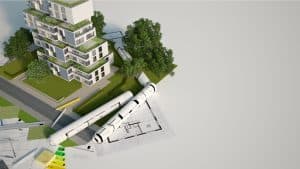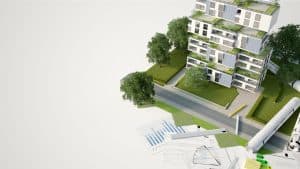Building Green

As humanity’s environmental footprint continues to expand, builders around the world are looking for ways to cut back on their resources and find greener solutions. This change will take time to implement, but it’s necessary for the future prosperity of our species and planet. Here are five ways construction companies can build green and create more sustainable projects>>>
the world are looking for ways to cut back on their resources and find greener solutions. This change will take time to implement, but it’s necessary for the future prosperity of our species and planet. Here are five ways construction companies can build green and create more sustainable projects>>>
Monitor Fuel Consumption
As you build, it’s important to monitor the fuel consumption of your tools and equipment. The burning of fossil fuels like oil and gas is a significant contributor to artificial climate change, so every effort helps. You can switch to electric vehicles to offset some of that consumption and transition to a more sustainable power source. Many auto manufacturers have started producing electric and hybrid heavy machinery.
You should also implement a fleet monitoring system to track the fuel consumption of each vehicle. This system not only keeps your vehicles safe from thieves, but also enables you to find out which specific units use the most fuel. Reducing the usage of these problematic vehicles or replacing them with electric alternatives, can significantly reduce your site’s fuel usage.
Cut Back on Paper Usage
If your company still uses paper as your primary project management tool, you’re doing something wrong. There’s nothing wrong with printing important legal documents, but you should no longer use it for blueprints, drawings, project specs, and payroll. You have far too many online tools at your disposal.
Today’s cloud-based project management software enables you to schedule the transportation of materials, calculate costs, perform risk assessments and track the project’s progress, among other things. You can also get your staff more closely involved with the planning process, making their jobs easier and allowing everyone to discuss environmentally beneficial solutions to problems around the site.
Use Eco-Friendly Building Materials
Instead of using cheap artificial goods like plastic and drywall to build your structures, switch to eco-friendly building materials. Wood and stone are the most practical and cost-effective solutions. They should serve as the building blocks for your projects from now on. They last longer and are more visually pleasing.
You should also create more eco-friendly materials like concrete from organic ingredients to give your projects a little more variety. Here are some other naturally-occurring materials you might use:
- Masonry
- Cork
- Bamboo
- Adobe brick
- Straw bale
- Cordwood
Even smaller-scale products like paint and insulation have green alternatives that conserve energy and contain fewer harmful chemicals. The entire building can consist of natural and simplistic materials if you take the time and effort to find them.
These products might be more expensive and difficult to acquire (especially if you only get them from local sources), but that’s a testament to their long-term value. You can’t think in the short term if you want to build sustainably. You want to think about creating lasting structures that will benefit the community and environment for decades to come.
Dispose of Waste Properly

Construction projects accumulate a lot of waste, including drywall, shingles, lumber, and other miscellaneous parts. You need to find better waste disposal solutions instead of shipping them off to a landfill. Start by disposing of glass, plastic, and metal at a recycling facility and finding new uses for other goods that still have value.
Most of the organic materials mentioned above have alternative uses. For example, you can convert lumber into mulch and easily transfer excess masonry to other projects. Metal objects can get smelted and converted into other products with entirely different functions. Using an item once doesn’t mean you have to throw it away.
You also need to control involuntary waste disposal, namely sedimentary runoff. Set up a silt fence around the perimeter to prevent hazardous materials from entering local water sources and ecosystems. This simple addition can significantly reduce pollution and soil erosion.
Work With Like-Minded Partners
Prioritize working with subcontractors and tradespeople who have similar ideas about sustainable construction. With similar environmental goals in mind, you can collaborate to create more sweeping solutions to your site’s problems.
A bit of peer pressure is also sometimes required to persuade stubborn companies into updating their business habits. When they see everyone around them stepping up to be more environmentally conscious, they will have no choice but to follow or get left behind. Harmful construction practices will only go away if we give eco-friendly solutions the opportunity to shine on a bigger scale.
Encourage your staff to be open and honest with each other about sustainability. If they see someone falling into bad habits, the rest of the team should be there to bring them back down to earth. Every day has countless opportunities to create a greener culture and work environment.
With enough time, you will create a network of like-minded business partners referring jobs to each other and bettering the community. Widespread change has to start somewhere, so why not be the catalyst for the change you want to see?
Build for the Future
The phrase “build for the future” takes on a new meaning when viewed through an environmental lense. We need to shift our focus from efficient structures to energy-efficient structures that will give back to the community and create a more harmonious world for our children and grandchildren.
By controlling fuel consumption and paper usage, utilizing green building materials, disposing of waste responsibly and working with like-minded people, you will create projects that have a lasting impact on everything around them. Stop building for the now and start building for the future!
Article by Jane Marsh
Author bio:
Jane works as an environmental and energy writer. She is also the founder and editor-in-chief of